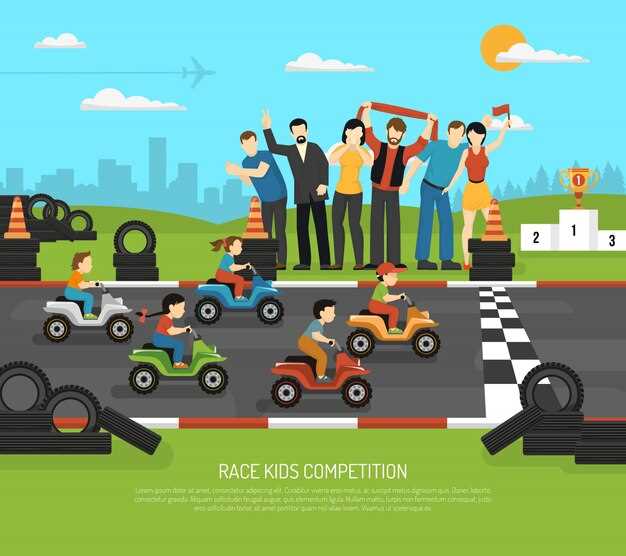
In the world of motorsport, few experiences rival the thrilling rush of karting. This exhilarating sport serves not only as an introduction to racing but also as a vital training ground for aspiring drivers. Go-karts, with their accessible design and lower costs, provide a perfect platform for young talent to develop essential skills such as vehicle control, race strategy, and competitive spirit.
The journey of a motorsport star often begins with humble go-karting experiences. Go-karts allow young enthusiasts to grasp the fundamentals of racing dynamics in a safe and controlled environment. As they navigate tight turns and accelerate down straights, aspiring racers learn the importance of precision and timing–skills that will serve them well in higher levels of competition.
Moreover, karting fosters a sense of community among participants. Drivers not only compete against one another but also share insights, tips, and camaraderie, laying the groundwork for the formidable networks that often characterize successful motorsport careers. Karting is more than just a sport; it is the foundation upon which future motorsport stars build their legacies.
Choosing the Right Go-Kart for Beginners
When diving into the world of karting, selecting the appropriate go-kart is crucial for beginners. Start by considering the age and size of the driver. Many manufacturers offer karts specifically designed for younger drivers, ensuring safety and comfort.
Next, evaluate the type of kart. Two main categories exist: racing karts and leisure karts. Racing karts are built for speed and competitive play, providing a more thrilling experience but often requiring a steeper learning curve. Conversely, leisure karts are ideal for casual driving, offering more stability and easier handling for newcomers.
Engine type is another important factor. Beginners should look for karts equipped with 4-stroke engines, as they are more forgiving and provide a consistent power delivery. These engines also tend to be quieter, which can enhance the enjoyment of the driving experience.
Safety features should always be a priority. Ensure that the chosen go-kart includes essential elements such as a sturdy frame, roll bars, and proper safety harnesses. Additionally, check that the kart has adequate braking systems to provide a reliable experience on the track.
Lastly, consider incorporating adjustable components in the kart, such as seat positioning and pedal accessibility. This ensures the kart can grow with the driver, accommodating their development and skill improvement in the exciting journey of karting.
Training Techniques for Young Aspiring Racers

Effective training techniques are crucial for young aspiring racers who wish to excel in karting. Developing fundamental skills at an early age sets the foundation for future success in motorsport. One essential technique is to focus on mastering basic driving skills, including smooth steering, acceleration, and braking. Consistent practice on various track layouts helps drivers adapt to different conditions and enhances their overall handling capabilities.
Incorporating mental training is equally important. Visualization exercises, where racers imagine themselves on the track, can significantly improve focus and reaction times. Additionally, understanding racecraft, such as overtaking strategies and defensive driving, allows young drivers to navigate competitive scenarios effectively.
Fitness plays a pivotal role in a driver’s performance. Physical conditioning, including cardiovascular workouts and strength training, helps build endurance and control during long races. Young athletes should engage in exercises that enhance core stability and neck strength, as these areas are critical for maintaining control throughout a karting event.
Another effective technique is participating in data analysis sessions. Reviewing lap times, speed, and racing lines through telemetry can help young racers understand their strengths and areas for improvement. Coaches can facilitate these sessions to provide personalized feedback and strategic advice.
Lastly, encouraging participation in different types of racing events exposes youngsters to varied competitive environments. Experiences in endurance races, sprints, and team-based formats help them adapt quickly and develop a well-rounded skill set, essential for any aspiring racer in the world of karting.
Understanding Safety Gear and Regulations in Karting

Safety is paramount in karting, as it ensures the well-being of drivers and promotes a competitive yet secure environment. Each karter must be equipped with appropriate safety gear, which typically includes a helmet, gloves, racing suit, and shoes designed specifically for motorsport activities.
The helmet is the most crucial part of a driver’s equipment. It must meet industry standards, such as those set by the Snell Foundation or the FIA, ensuring that it can withstand high-impact forces. A full-face helmet is recommended to provide maximum protection for the head and face. Additionally, the helmet should be fitted with a visor or goggles to shield the eyes from debris and improve visibility.
Racing suits are designed to be fire-resistant, providing an essential layer of thermal protection in the event of an accident. These suits should cover the entirety of the driver’s body and fit snugly to minimize the risk of snagging on any equipment during a race. Many suits have added features such as reinforced stitching and padded areas for extra safety.
Footwear is another critical aspect of safety gear. Racing shoes should be lightweight, provide good grip, and protect the driver’s feet from heat and abrasion. Furthermore, gloves designed for karting enhance grip on the steering wheel and protect the hands from potential injuries.
Apart from personal safety gear, drivers must also be familiar with karting regulations that vary by jurisdiction and specific karting events. These regulations often include rules about kart specifications, engine capacities, and technical inspections, ensuring fair competition and safety for all participants. Adhering to these standards not only keeps each karter safe but also helps elevate the sport’s integrity.
In summary, understanding and complying with safety gear requirements and regulatory standards in karting is essential for every aspiring motorsport star. Proper preparation and adherence to safety protocols lay the groundwork for a successful and safe racing career.












